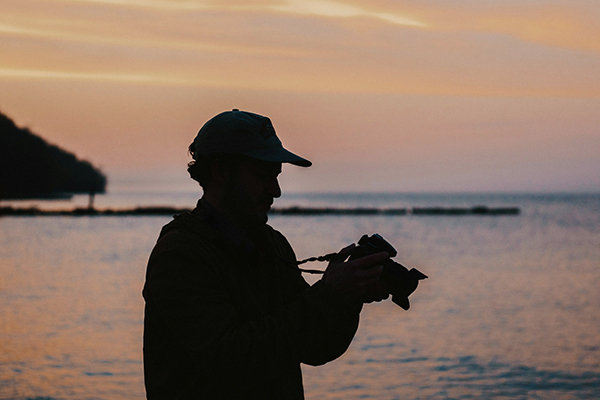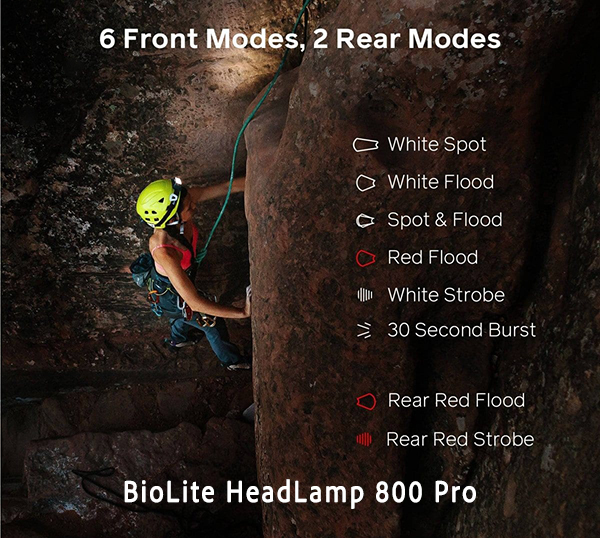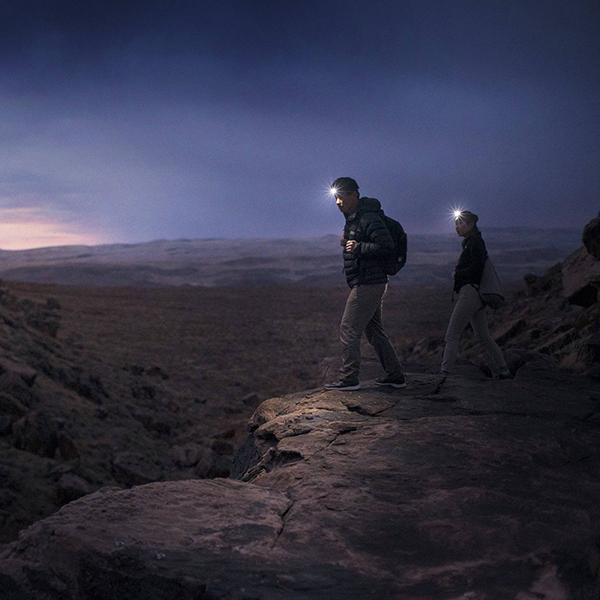Put light where you need it. BioLite headlamps are affordable, comfortable and extremely well-made. As a photographer you’ll find them an indispensable nighttime companion. And it you ever have to change a tire on a dark road, search at midnight for a doggo that wandered off, or face any emergency that includes a loss of power, you need a headlamp.

Why Do Photographers Need Headlamps?
The interior of way too many camera bags and photo backpacks is black as soot. How can anyone find a black lens cap against a black background when shooting after sunset? Grey isn’t much better. And holding a Mini Maglite in your teeth while rummaging through your pack is not recommended unless you’re blessed with evergrowing incisors like a beaver. A headlamp is the perfect solution.
BioLite HeadLamps
With names that reflect their output power in lumens, the four BioLite HeadLamp models are easy to differentiate. Prices range from less than $30 to about $75 (may reflect temporary or seasonal price reductions) but when you need one, they’re priceless. If you take away nothing else from this review, buy a 200-lumen BioLite HeadLamp 200 for $30 and keep it in the glove box. You won’t regret it.

BioLite HeadLamp 800 Pro
The BioLite HeadLamp 800 Pro is the flagship model in their four-unit lineup. It’s rechargeable and contains a premium 3000 mAh Lithium-ion battery that can last up to a whopping 150 hours in Low Power mode. It has a multifunction, rear-facing red light that’s potentially a literal lifesaver for joggers, cyclists and climbers. Furthermore, it’s water and dust resistant with a classification of IPX4. (For a deeper explanation of the levels of Ingress Protection (IP), officially international standard IEC 60529, check out this story.)
The BioLite HeadLamp 800 Pro can be charged using a standard charger or computer. For extended use it can be connected to a separate power bank (a/k/a battery brick) like the BioLite Charge 100 Max we reviewed here.

With an approximate range of 135 meters (about 150 feet) the BioLite HeadLamp 800 Pro provides a maximum illumination level of 800 lumens. That’s about the same as a 60 Watt incandescent lightbulb. Even when activated at a lower power setting, you can summon a 30-second burst of 800 lumens if need arises. HeadLamp 800 delivers multiple warnings when the battery power drops, then switches to 8 hours of Low Mode so you’re never suddenly left in the dark.
In the Field
The head harness is very comfortable, and the light weight of 5.3 ounces (150g) allows for easy long-term wear. I used it outdoors at night on several occasions and found the ability to adjust the beam angle immensely convenient, particularly when navigating the stairs on my deck.
 Altogether there are six (6) forward lighting modes, and two (2) red rear-facing. The red modes (flood and strobe) provided a definite feeling of security when walking aside traffic at night. I don’t cycle, but I’m sure cyclists will love it.
Altogether there are six (6) forward lighting modes, and two (2) red rear-facing. The red modes (flood and strobe) provided a definite feeling of security when walking aside traffic at night. I don’t cycle, but I’m sure cyclists will love it.
As mentioned above, the BioLite HeadLamp 800 Pro comes with a cable that’s long enough for connection to a power bank while being worn. This is a surprisingly easy and comfortable configuration. The same cable (USB Type A to Mini USB) is used to charge the internal battery using any standard charger.
Conclusion
Highly recommended! And the ideal holiday gift for anyone in your life who cannot see in the dark. You’ll find it essential during any lighting-related emergencies and when capturing images after Golden Hour.

Price & Availability
Price of the BioLite HeadLamp 800 Pro from Amazon is $74.95 and it’s available now. You can also order directly from BioLite for the same price. Pricing may reflect temporary or seasonal price reductions, an unavoidable peril of online journalism.
At the very least, buy a 200-lumen BioLite HeadLamp 200 (described below) for $30 and keep it in the glove box. You’ll travel safer.
Three More BioLite HeadLamp Models to Choose From

BioLite HeadLamp 425
The BioLite HeadLamp 425 provides 425 lumens, runs for 4 hours in High Mode and 60 hours in Low Mode. It also has a rear-facing red light. Rechargeable battery is built in, and it’s just 10mm (0.4 inches) thick. Available in Midnight Grey, Ocean Teal and Ember Yellow colorways and can be ordered for $44.96 directly from BioLite. Also available from Amazon.

BioLite HeadLamp 325
The BioLite HeadLamp 325 produces 325 lumens and also comes in Ocean Teal, Midnight Grey and Ember Yellow colors. Built-in battery charges via USB. It weighs next to nothing (1.75 ounces, or 50g) and is just 18mm (0.7 inches) thick. It runs for 40 hours on Low and 3 on High Mode. Order it from Amazon for $37.46.

BioLite HeadLamp 200
Currently priced at $29.96 directly from BioLite, the BioLite HeadLamp 200 comes in Midnight Grey, Moss Green, Ocean Teal or Ember Red and otherwise has the about same specifications as the 325 with the exception of its lower 200 lumen output. Also available on Amazon.
Prices indicated may be temporary or seasonal price reductions. Visit BioLite to confirm particulars. Check out the Official BioLite Store on Amazon. They offer a very broad range of products that can extend the enjoyment of spending time outdoors.
Become a Member of the Shutterbug Community
Register for a free account. Sign up for our newsletter. Spend five minutes (or less) uploading your best shots once every week or so — or once a month; it’s up to you. Potentially become a Shutterbug Photo of the Day winner. Enjoy viewing the fantastic work being done by thousands of photographers all over the world—and add your images to the enduring collection.
—Jon Sienkiewicz
(As an Amazon Associate, Shutterbug earns from qualifying purchases linked in this story.)





 Altogether there are six (6) forward lighting modes, and two (2) red rear-facing. The red modes (flood and strobe) provided a definite feeling of security when walking aside traffic at night. I don’t cycle, but I’m sure cyclists will love it.
Altogether there are six (6) forward lighting modes, and two (2) red rear-facing. The red modes (flood and strobe) provided a definite feeling of security when walking aside traffic at night. I don’t cycle, but I’m sure cyclists will love it.








